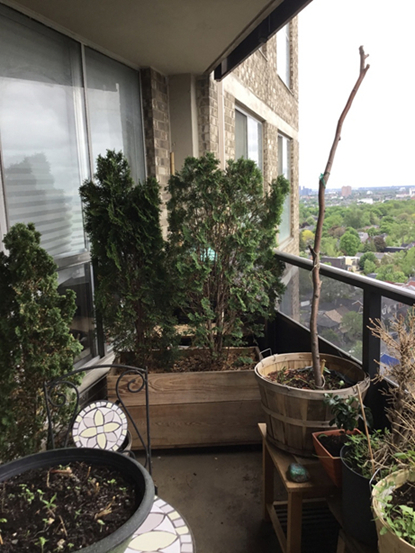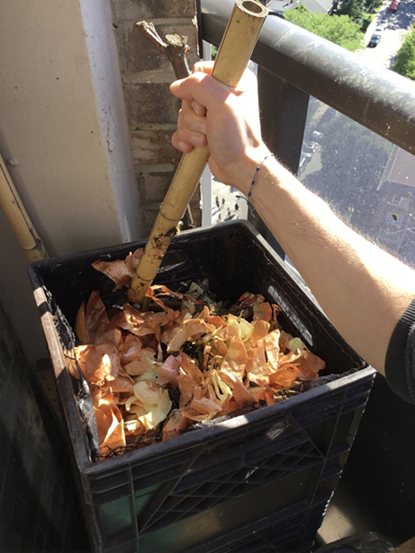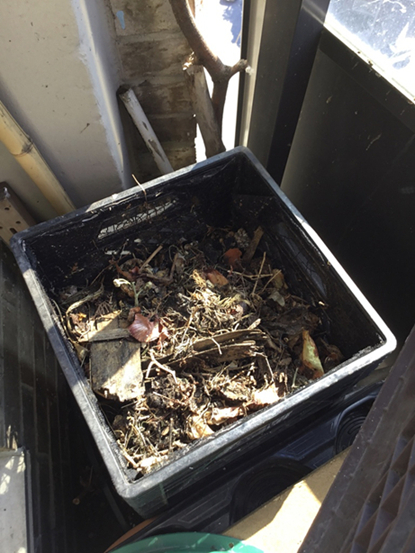
| Home | Source Reduction | Friends of Green Friends | Newsletters |
| Gardening | Resources | What You Can Do | Embracing The Trees |
| Milk Crate Compost - Easy & Effective Ideas for Backyards and Balconies |
 The compost stack sits behind the trees |
|
I’m lucky enough to live in a city with industrial compost - Toronto, Canada. We divide our household waste into garbage, recycling, and compost. We get curbside pick-up for each.
I was merrily composting using my city’s service for years. Then I moved into a building complex, where I learned that apartment buildings have the option to opt-out of city compost. What?! My composting days came to a sudden halt. My garbage output was now double or triple what it used to be. I couldn’t sit with that for long. I started separating my compost again, and bringing it along with me to friends’ houses, to deposit into their compost bins. This was not a long-term solution (for my compost problems or my popularity). So we researched how to have our own compost. Not even a backyard compost; a balcony compost! Of course we had some concerns:
We investigated worms; we concluded they’d die over the winter on our balcony. We investigated commercial backyard compost devices; they would not fit on our balcony. We investigated use of heat and other fancy methods; it was expensive, impractical, or we had concerns with the environmental impact of the composter itself. Finally, we found something just right. Simple. Smell-free. Low/no-cost. Small. And effective. |
 Here is the stack of composting crates |
|
Our System We have three milk crates. We purchased some mesh-like material to line the inside of the bins. There needs to be air flow, but the holes of the milk crates would be too large and things would fall out. We stacked our crates. This is ideal because they take up less space that way. The stacking also allows moisture to drip down and soluble nutrients to fall through to the bottom. Each crate contains a different stage of compost. The bottom is the closest to dirt. The top has fresh compost, barely decomposed. My job is to feed the compost. I fill a small bucket with veggie scraps. My husband periodically empties that bucket into our milk crate system. New scraps go into the top box. It gets mixed with dry leaves (we collect those from our neighbours in the fall) or tiny dry paper-like scraps. The top box gets stirred with a big stick about once a week, to make sure oxygen is getting in. (If it’s not stirred, it would grow unhealthy bacteria and produce more methane). We also add water to the top box. Imagine as if you were watering a houseplant, about once a week. This helps keep it humid. If you see fruit flies, they are likely helping to speed up decomposition. |
 The top crate being stirred with fresh scraps |
|
When the top box is about 3/4 full, most of it gets moved down to the middle box. The top box remains about 1/4 full, when the middle one receives it’s new load of compost. The middle box doesn’t need stirring as frequently. It only gets stirred when it’s getting filled. When the middle box reaches about 3/4 full, it similarly has most of its contents emptied into the bottom box. This might happen about once or twice a year (note: our composting ‘year’ is pretty short in Canada). In early spring, we take composted material from the bottom box and put it into our garden pots. It’s kind of a lumpy looking soil, so it’s not perfect, but it does the trick. |
 The middle crate; halfway to becoming soil |
|
What Goes In The list of acceptable items for an industrial compost facility is quite long: veggie scraps, meat scraps, paper muffin wrappers, even diapers. They do not, however, compost "compostable plastic" like those misleading "biodegradable bags or cutlery". Virtually no city is equipped to compost “biodegradable plastic” because it requires a significantly higher temperature and about three times more time, which is simply not cost-effective or even possible for any municipality, but I digress. The backyard or balcony compost takes: fruit and veggie scraps. You don’t want dairy or animal products in there, as it will create an unpleasant smell and disrupt your happy compost. Egg shells are not harmful, but they don’t really break down. Tiny scraps of egg carton or bathroom tissue or dried leaves are useful. |
 The bottom crate can be put into a garden and used as soil |
|
The Winter and the Un-compostable Once winter hits, our compost slows down and stops. Without heat, nothing breaks down. And pretty soon the compost is frozen solid. We can add a few more veggie scraps, but after not too long, there is no more space. The balcony compost is closed for the winter. I’ve taken to storing my scraps in a plastic bag on the balcony. It’s frozen, so there’s no mess and no smell. This would amount to too much to introduce to our balcony compost in the spring though, plus it would be melting and messy by the time the compost re-opens. So I deal with it while it’s still frozen. My neighbourhood has lots of community boards and forums. I sent out a request to use someone else’s city compost bin during the winter. A few willing neighbours offered their bins, so I occasionally take a walk with my frozen compost bags to be deposited into an available bin. I do the same for other items I acquire that don’t go in our compost, but do go in the city compost. Like a paper muffin wrapper, an excess of egg shells, or a giant avocado pit. But otherwise, we are able to compost the majority of our food waste, right on our balcony. I hope I’ve inspired you to start a compost. I would have thought it sounds hard, but really, it’s not. This is our third year using the milk crate compost and we’ve had no issues at all with smell or bugs or anything else. Of course it takes a little effort, but anything we can do for Nature is a way to show our gratitude for everything She does for us. Natasha - Toronto, Ontario |
Read Bluebirds of Happiness from the Summer 2020 newsletter >>
| Home | Source Reduction | Friends of Green Friends | Newsletters | Resources | What You Can Do | Contact Us |
For more information, e-mail info@greenfriendsna.org |
||||||